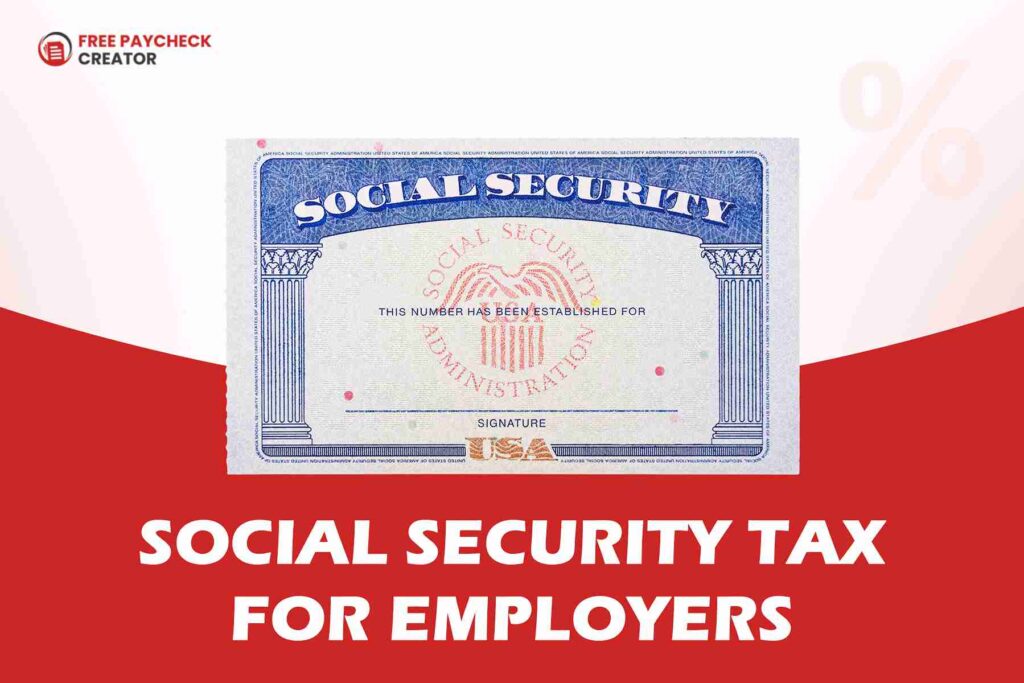The Social Security tax for employers is important to understand in order to stay compliant with the federal tax laws. This tax helps fund the U.S. Social Security program, which provides benefits for disabled workers and the families of deceased workers.
In this guide, we will be looking at the social security tax for employers, its role in the process, and how you can ensure compliance.
Create Accurate Pay Stubs in Minutes
Stay compliant with Social Security tax rules by generating professional pay stubs for free.
What is Social Security Tax?
Social security tax is a section of the Federal Insurance Contributions Act (FICA), which requires both employees and employers to contribute to the social security program. This program provides benefits for disabled workers and the families of deceased workers.
Most of the employers automatically hold back social security taxes from employees’ paychecks and send them to the government. On every employee’s paycheck, social security taxes should be there, among other taxes that are withheld.
Why is the Social Security Tax for Employers mandatory?
The social security tax for employers is requested under the Federal Insurance Contributions Act. The aim is for current workers to support older and retired workers in case of disability and retirement.
The social security tax funds the social security program, which pays for the retirement and disability benefits to more than 68 million Americans every month.
2025 Social Security Tax Quick View
| Item | Rate / Limit |
|---|---|
| Employee Social Security Tax | 6.2% |
| Employer Match | 6.2% |
| Total Rate | 12.4% |
| Base Wage Limit | $176,100 |
- The social security tax for 2025 will remain the same at 6.2% for both the employer and employee.
- Employers are required to match the 6.2% contribution, making the total tax rate 12.4%.
- Employers’ contributions will continue to be deducted from their paychecks, and employers will set aside their portion for the IRS.
What is considered the Social Security base limit?
For 2025, the social security tax base limit is $176,100. This means that the social security tax only applies to the first $176,100 of an employee’s earnings. Earnings above this limit are not subject to the social security tax for the whole year. Although the Medicare tax has no earnings cap, it applies to all income.
What should be your responsibilities as an employer?
The following are the responsibilities of being an employer:
Withhold the employee portion:
Being an employer, you are responsible for withholding 6.2% of each employee’s gross wages for social security tax, up to the social security tax limit.
Once an employee’s earnings exceed this limit, social security tax is no longer withheld from their wages for the whole year, but Medicare tax still gets applied.
Pay the employer portion:
You should contribute 6.2% as the employer’s portion, which is paid directly to the IRS. This amount is deducted from the employee’s wages.
File and report the social security tax:
Employers must file an IRS Form 941 quarterly, reporting both the employees’ and the employer’s contributions to the social security tax.
Pay the taxes:
Depending on the total amount of taxes you withheld, the IRS shall assign to you a direct deposit schedule, either monthly or semi-weekly.
Get Compliant Pay Stubs Instantly
Generate professional stubs with correct deductions—perfect for Social Security tax reporting.
Filing and Reporting Social Security Tax for Employers 2025
The reporting and filing of social security tax for employers in 2025 are as follows:
- ✅ Form 941: Employers should file a Form 941 quarterly to report wages and tax withholdings, including social security and medicare taxes.
- ✅ Tax Payments: Social security tax payments must be made on time to avoid penalties.
- ✅ Record-Keeping: It is vital to maintain accurate records of wages, tax withholdings, and contributions for at least four years.
Social security tax for employers is crucial not only for employers but for retirees and families, which includes:
- Retirement benefits: Monthly income for retirees who have paid into the system.
- Survivor benefits: Benefit for family members of deceased workers.
- Disability benefits: Support for workers who have become disabled.
FAQs For Social Security Tax for Employers
1- What is the maximum Social Security payment?
The maximum Social Security benefit you’re eligible for depends on the age you retire. For example, if you retire fully in 2025, your maximum monthly Social Security benefit would be $4,018.
2- What is the concept of Social Security?
The concept of social security is a society’s system of public protection against economic and social distress which is caused by risks like unemployment, illness, old age providing income and health care to make sure there is a minimum standard of living.
3- Who is eligible for Social Security?
Social security at the age of 62 or older are insured for having enough work credits.
4- How to check for fake paystubs?
You can use the pay stub generator to create professional pay stubs. Common signs of a fake pay stub include incorrect formatting, inconsistent fonts, misspelled words, math errors lack of important information such as taxes and deductions.
Key Takeaways – Social Security Tax for Employers
Grasping the concept of Social Security Tax for Employers is key to proper payroll management. Keeping up with the current rates, duties, and filing requirements, employers not only steer clear of errors that may cost a great deal of money but also become a source of financial stability to the staff members.
A Free Paycheck Creator– pay stub generator can undoubtedly become a great helping tool in the accomplishment of this task, facilitating employers in the computation of the proper deductions and the issuance of professional pay stubs.
Stay Tax-Compliant Effortlessly
Use our free paycheck creator to generate accurate pay stubs and meet every IRS requirement.







